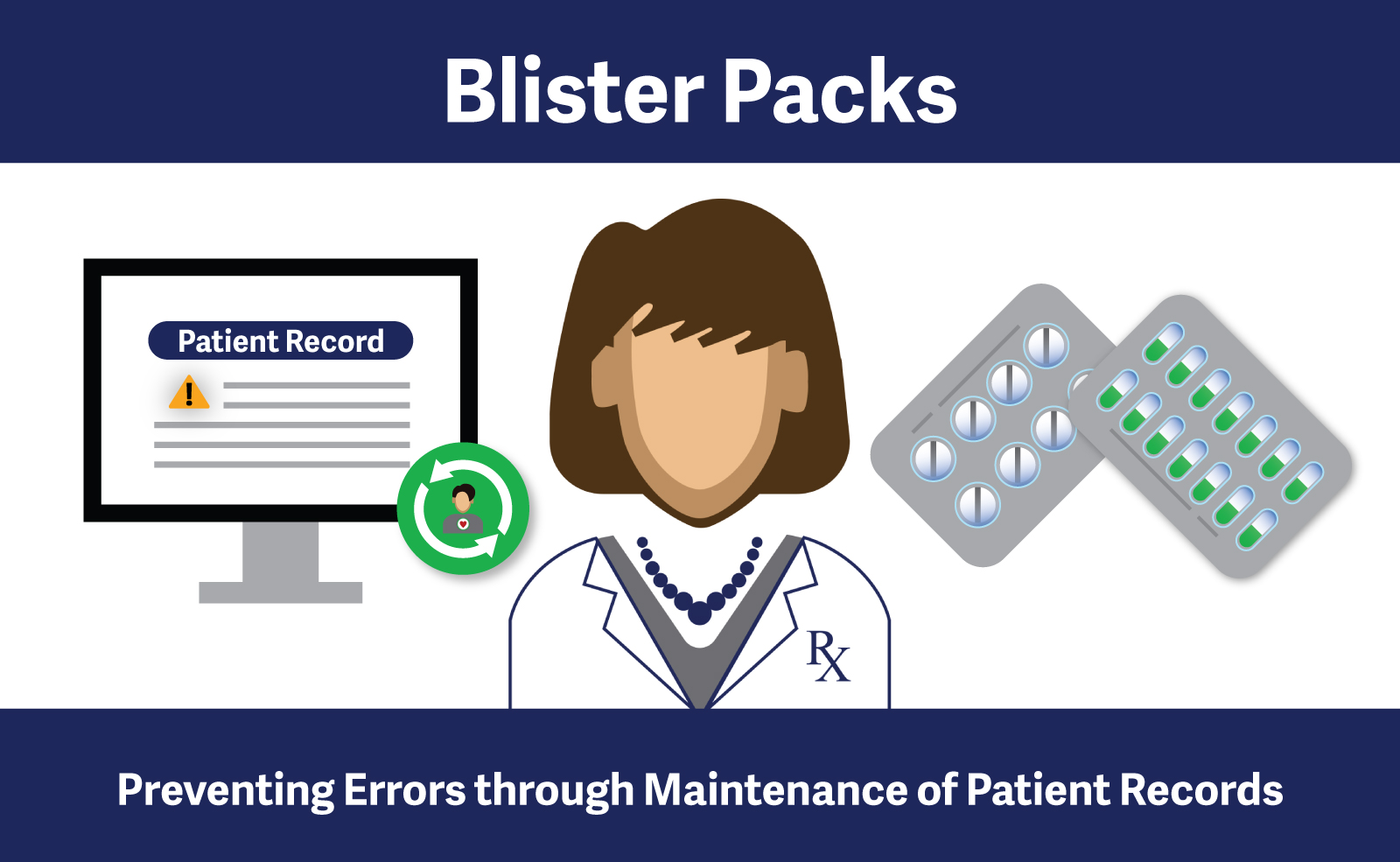Blister Packs and Preventing Errors Through Maintenance of Patient Records
Compliance packs, more commonly known as “Blister Packs”, are a useful tool to increase medication adherence in patients experiencing difficulties with medication management.
However, due to the often-complex nature of the medication regimens; the potential for frequent therapy changes; and the multi-step process required for dispensing in compliance packs, they also introduce increased risks for errors to occur. Registrants need to be aware of these increased risks, and how to prevent errors from occurring for medications dispensed in this manner.
Preventing Errors through Maintenance of Patient Records
An effective way to prevent errors associated with the compliance packaging process is to ensure patient records are up-to-date and properly maintained.
The following examples illustrate how improper patient record management can lead to medication errors.
Scenario 1: Ensuring PharmaNet records are kept up-to-date when changes are madeMs. Smith, a patient who has been receiving her medications in a compliance pack, presents to the pharmacy with her partially used compliance pack and a new prescription for a dose reduction of her ramipril. She is currently taking ramipril 5mg twice daily in the morning and at bedtime and the new prescription is written for ramipril 5mg once daily in the morning. The pharmacist decides that a new supply is not required to make this change to her compliance pack. Instead, the pharmacist removes the bedtime dose of ramipril from her remaining compliance packs and puts the new prescription on hold, to be filled when she is due for her next pack. Issue: As a result of this pharmacists actions, Ms. Smith’s PharmaNet profile is now inaccurate. While Ms. Smith is still receiving the correct dose, because her new prescription for a reduced dose was put on hold, rather than being transmitted to PharmaNet, her PharmaNet record incorrectly reflects her current dose. PharmaNet records, are particularly important in hospital settings, where they are relied on by healthcare professionals to determine what medications patients are taking when they are admitted. In the absence of any additional information from the patient or the patient’s caregivers, the patient’s medications would be ordered based on what appears on their PharmaNet record. Inaccuracies in a patient’s PharmaNet record can result in the patient receiving the wrong medications and/or dosages, putting them at risk of potential drug-therapy problems. Solution: Whenever changes are ordered for a patient’s medication regimen, whether it be a dose increase, decrease, addition or discontinuation, it is important that this information is transmitted to PharmaNet so that the record is kept up-to-date. This is a legislated requirement as per PODSA Bylaws s.35(1): “35. (1) A registrant must enter the prescription information and transmit it to PharmaNet at the time of dispensing and keep the PharmaNet patient record current.” |
Scenario 2: Ensuring local patient records are being maintainedMr. Jones, a patient who has been receiving his medications in a compliance pack, presents to the pharmacy with his partially used compliance pack and a new prescription for a dose increase of his Synthroid. He is currently taking Synthroid 75mcg once daily in the morning and the new prescription is written for a dose increase to Synthroid 88mcg once daily in the morning. A pharmacy assistant processes the prescription for the increased dose, putting the 88mcg tablets into the existing compliance pack and removing the 75mcg tablets. A pharmacist conducts a PharmaNet check and the final check, but fails to review the patient’s local profile to ensure it has been updated appropriately. Issue: It is important to keep in mind that the patient’s local record must be kept up-to-date and accurate. A pharmacist must review the patient’s local profile when prescriptions are transmitted and dispensed. In this scenario, the pharmacist should have ensured that the old prescription for Synthroid 75mcg once daily had been discontinued/deactivated from the patient’s profile. Missing this step could potentially lead to errors when preparing the patient’s next compliance pack. For instance, if the Synthroid 75mcg is still active in the patient’s local profile, it may accidentally get flagged for refill, along with the Synthroid 88mcg. This could result in accidental packaging of both strengths and/or inaccuracies on the patient’s local and PharmaNet records. Solution: Registrants are responsible for ensuring that patient records are being maintained as per HPA Bylaws Schedule F Part 1 s.11(1): “11. (1) A patient record must be established and maintained for each patient for whom a Schedule I drug is dispensed.” In addition, HPA Bylaws Schedule F Part 1 s.5(b) states that a pharmacist must: “(b) review patient personal health information for drug therapy problems, therapeutic duplications and any other potential problems,” In addition to reviewing the patient’s PharmaNet record, the pharmacist must also review the personal health information on the patient’s local record when dispensing a prescription. Registrants are responsible for maintaining this record as per section 11(1) to ensure that it is accurate and up-to-date. Although this step is always important, regardless of whether you are dispensing in compliance packs or vials, compliance pack patients are particularly vulnerable to having these types of errors go unnoticed. |

 Share
Share



